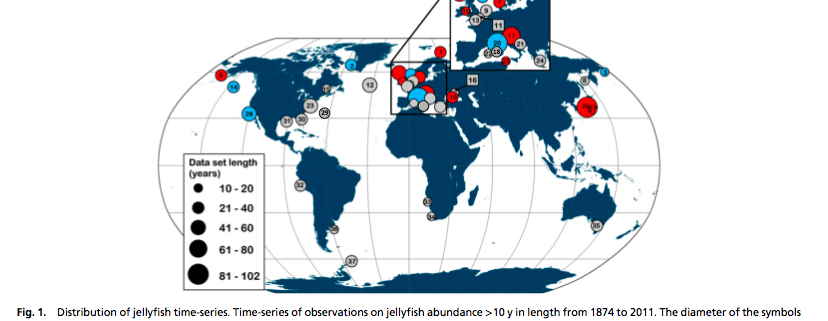Jellyfish Blooms are the Result of Global Oscillations
by Megan Piechowski, RJD Intern
A recently observed increase in the abundance of jellyfish populations has been suggested to be a symptom of deteriorating oceans. Other indicators include: ocean acidification, eutrophication, and declining fish stocks. However, this conclusion might have been reached prematurely as a thorough and formal analysis of the long-term fluctuation of global jellyfish populations did not exist. In Recurrent Jellyfish Blooms Are a Consequence of Global Oscillations, Condon et al gathered data sets containing the distribution of jellyfish populations from thirty-seven locations around the world between the years of 1790 to 2011 (picture 1).
They found that although this data is immense it is mostly restricted to the Northern Hemisphere, focusing in the Atlantic Ocean and the Mediterranean region. The available data is also limited by the lack of research and information collected from the past two hundred years. This team of scientists set out to statistically determine if “jellyfish population size and the occurrence of blooms have not significantly increased in the world’s oceans.”
The analysis by Condon et al resulted in an inability to reject their hypothesis. They determined that although there has been a recently observed increase in jellyfish populations, that the pattern of blooms appears to follow a decadal oscillation of increases and decreases. Since the 1970’s there has been a weak increase in the baseline abundance of jellyfish. The authors attribute this slight increase to a number of global and regional changes in the ocean that support the life history of jellyfish. This includes: an increase in temperature which increases feeding and growth rates, overfishing jellyfish competitors, a decrease in oxygen causing hypoxia (which jellyfish have a greater tolerance to withstand), and an increase in nutrients in coastal waters causing higher concentrations of planktonic food for the jellyfish. This study demonstrates the strength of data produced by long-term observation programs, highlighting the limitations of modeling systems and experimental research. These methods would likely lack the ability to identify the unique oscillatory trends that Condon et al discovered. The researchers stress the importance of continued global monitoring of populations to determine future maxima and minima in the oscillation periods. Condon et al concluded, “Impacts of rises in jellyfish abundance are enhanced by increasing exposure derived from the increased interaction between humans and the coastal ocean.” This suggests that although jellyfish populations follow a pattern of rising and falling that the overall abundance can be increased by the impact of certain anthropogenic changes to the ocean.
REFERENCES
Condon, Robert H., Carlos M. Duarte, and Kylie A. Pitt. “Recurrent Jellyfish Blooms Are a Consequence of Global Oscillations.” N.p., 28 Nov. 2012.





Leave a Reply
Want to join the discussion?Feel free to contribute!